
The Alte Pinakothek is an art museum located in the Kunstareal area in Munich, Germany. It is one of the oldest galleries in the world and houses a significant collection of Old Master paintings. The name Alte (Old) Pinakothek refers to the time period covered by the collection—from the fourteenth to the eighteenth century. The Neue Pinakothek, re-built in 1981, covers nineteenth-century art, and Pinakothek der Moderne, opened in 2002, exhibits modern art. All three galleries are part of the Bavarian State Painting Collections, an organization of the Free state of Bavaria.

The Descent from the Cross, or Deposition of Christ, is the scene, as depicted in art, from the Gospels' accounts of Joseph of Arimathea and Nicodemus taking Christ down from the cross after his crucifixion. In Byzantine art the topic became popular in the 9th century, and in the West from the 10th century. The Descent from the Cross is the 13th Station of the Cross.

The Cathedral of Our Lady is a Roman Catholic cathedral in Antwerp, Belgium. Today's see of the Diocese of Antwerp started in 1352 and, although the first stage of construction was ended in 1521, has never been 'completed'. In Gothic style, its architects were Jan and Pieter Appelmans. It contains a number of significant works by the Baroque painter Peter Paul Rubens, as well as paintings by artists such as Otto van Veen, Jacob de Backer and Marten de Vos.

The Elevation of the Cross is the name of two paintings, a very large triptych in oil on panel and a much smaller oil on paper painting. Both pieces were painted by the Flemish artist Peter Paul Rubens in Antwerp, Belgium, the original in 1610 and the latter in 1638.
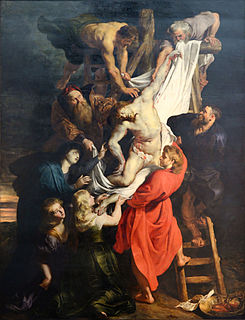
The Descent from the Cross is the central panel of a triptych painting by Peter Paul Rubens in 1612–1614. It is still in its original place, the Cathedral of Our Lady, Antwerp, Belgium, along with another great altarpiece The Elevation of the Cross. The subject was one Rubens returned to again and again in his career. This particular work was commissioned on September 7, 1611, by the Confraternity of the Arquebusiers, whose Patron Saint was St. Christopher.

Sir Peter Paul Rubens was a Flemish artist and diplomat from the Duchy of Brabant in the Southern Netherlands. He is considered the most influential artist of the Flemish Baroque tradition. Rubens's highly charged compositions reference erudite aspects of classical and Christian history. His unique and immensely popular Baroque style emphasized movement, colour, and sensuality, which followed the immediate, dramatic artistic style promoted in the Counter-Reformation. Rubens was a painter producing altarpieces, portraits, landscapes, and history paintings of mythological and allegorical subjects. He was also a prolific designer of cartoons for the Flemish tapestry workshops and of frontispieces for the publishers in Antwerp.

Deodat del Monte, Deodat van der Mont or Deodatus Delmont was a Baroque painter, architect, engineer, astronomer, and art dealer who was part of the inner circle of Peter Paul Rubens.
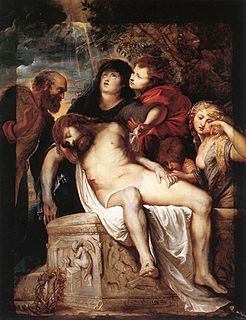
The Deposition is a 1602 painting of the Deposition of Christ by Peter Paul Rubens, previously attributed to Van Dyck. It is not to be confused with Rubens' much larger and more famous Descent from the Cross in Antwerp Cathedral. It is now in the Galleria Borghese.

Pieter van Mol or Peter van Mol was a Flemish painter known for his history paintings of religious subject matter, and to a lesser extent for his allegorical compositions, genre scenes and portraits. His style was profoundly influenced by Rubens, Abraham Janssens and Artus Wolffort. He was court painter to the King and Queen of France.
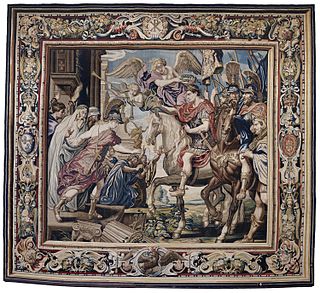
The History of Constantine is a series of tapestries designed by Flemish artist Peter Paul Rubens and Italian artist Pietro da Cortona depicting the life of Constantine I, the first Christian emperor of Ancient Rome. In 1622, Rubens painted the first twelve oil sketches that were used as guides, and the tapestries themselves were woven in the workshop of Marc Comans and François de la Planche in the Faubourg Saint-Marcel in Paris by 1625, transforming each small sketch into a sumptuous creation of wool, silk, and gold and silver threads that could easily fill a wall. An additional five designs were painted by Cortona in 1630 and woven in the atelier of Cardinal Francesco Barberini in Rome over the next decade.

The Musée des Beaux-Arts d'Arras is located in the old Abbey of St. Vaast in Arras, in the Nord-Pas-de-Calais, France.
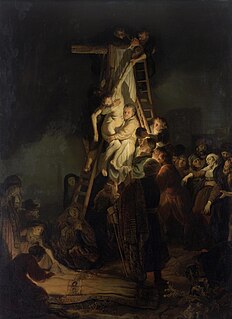
Descent from the Cross (1634), by Rembrandt Harmenszoon van Rijn, is one of his many religious scenes. The piece is oil on canvas and now located in the Hermitage Museum in St. Petersburg. The piece is intriguing stylistically in its unique figural composition and variety of lighting effects. Aside from composition, the painting is notable in terms of its historical context, from the connection between its subject matter and Rembrandt's family situation to its endangered location during World War II.
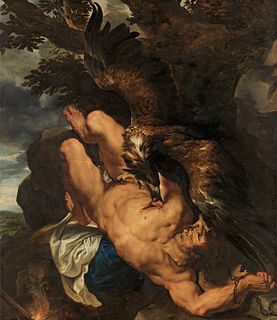
Prometheus Bound is an oil painting by Peter Paul Rubens, a Flemish Baroque artist from Antwerp. Influenced by the Greek play, Prometheus:The Friend of Man, Peter Paul Rubens completed this painting in his studio with collaboration from Frans Snyders, who rendered the eagle. It remained in his possession from 1612 to 1618, when it was traded in a group of paintings completed by Rubens, to Englishmen Sir Dudley Carleton in exchange for his collection of classical statues. This work is currently in the collection of the Philadelphia Museum of Art, Pennsylvania.

The Garden of Eden with the Fall of Man or The Earthly Paradise with the Fall of Adam and Eve is a painting by Peter Paul Rubens (figures) and Jan Brueghel the Elder. It is housed in the Mauritshuis art museum in The Hague, Netherlands. The painting depicts the moment just before the consumption of forbidden fruit and the fall of man.
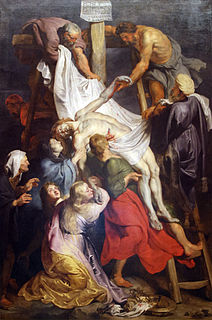
The Descent from the Cross is a painting by Peter Paul Rubens, produced around 1616-1617 for the chapel of the Capuchin convent in Lille. It was seized by France and was part of the founding collection of the Palais des Beaux-Arts de Lille, where it is still housed.
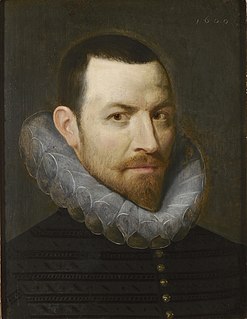
Nicolaas Rockox (1560–1640), was a mayor of Antwerp. He was a close personal friend and important patron of Peter Paul Rubens. His residence in Antwerp is now a museum known as the Rockox House. He was knighted by Archdukes Albert and Isabella, the Governor General of the Southern Netherlands.

Descent from the Cross is an oil on panel painting of 1600–1602 by the Flemish artist Peter Paul Rubens. It was his first major commissional work made for the private chapel of Eleonora de’ Medici Gonzaga (1567–1611), duchess of Mantua. The painting remained somewhat obscure until 2005, when it was discovered by German art historian Justus Müller-Hofstede, a specialist on Rubens' early work.
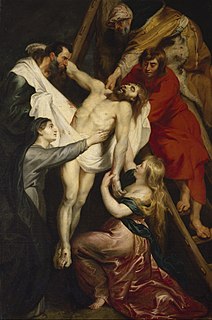
The Descent from the Cross is a c.1618 oil on canvas painting by Peter Paul Rubens and his studio. The broad free brushstrokes of the old man's body and robes point to Rubens' pupil Anthony van Dyck. It is now in the Hermitage Museum in St Petersburg.
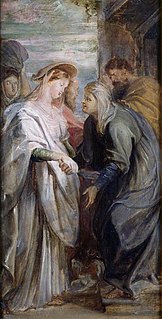
Visitation is a 1610s oil painting by the Flemish Baroque artist Peter Paul Rubens. It is now in the Musée des Beaux-Arts of Strasbourg, France. Its inventory number is 198.


















